The Welsh springer spaniel is a medium-sized, sporting dog of British origin. Welsh springer spaniels are also commonly referred to as Welsh springers, welshies, and Welsh spaniels.
These dogs love to be active and have fun, so they do well in households that can provide them with enough time to play and exercise.
Welsh springer spaniels typically cost $1,200 to $3,500 USD.
TABLE OF CONTENTS
What is a Welsh Springer Spaniel?
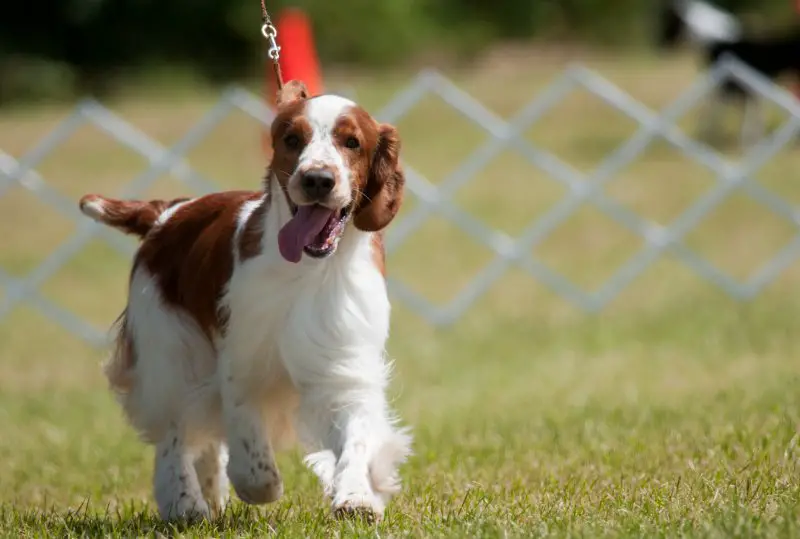
From Adobe Stock
The Welsh Springer Spaniel is one of Great Britain’s oldest sporting breeds, a descendant of the original spaniel dogs from the Iberian Peninsula. The name “Spaniel” derives from “Spaniard”, but it is unknown how the dogs made their way from ancient Spain to Wales. The breed was once used for hunting but is now an affectionate, loyal family dog.
All Spaniel breeds are thought to have origins in Spain. English Cocker Spaniels, English Springer Spaniels, and Welsh Springer Spaniel probably all share some of the same DNA. But as breeds were created or altered for specific purposes, and as they were often isolated from other dogs for several generations, their characteristics began to significantly differ from one type to the next.
Spaniels were divided into Land Spaniels and Water Spaniels, depending on where they demonstrated their greatest hunting prowess, with Welsh Springer Spaniels being Land Spaniels. “Cocker” Spaniels were bred to hunt Eurasian woodcocks, and “Springers” were bred to “spring” or flush game out of the brush so hunters could send falcons in for the kill.
Dogs resembling Welsh Springer Spaniels appear in British literature and art from as long ago as 250 BC and have been called the Welsh Spaniel and the Welsh Cocker Spaniel over the years. They are depicted with a distinctive red and white coat. John Caius wrote about the breed in 1570, “Spaniels whose skynnes are white and if marked with any spottes they are commonly red.”
There is a theory that once these dogs arrived in Wales and were raised by local hunters and sportsmen, inbreeding commenced and the unique coloring was reproduced and preserved. Living on the isolated Isle of Wales for so long, the members of the breed didn’t mix with other dogs, and the Welsh Springer Spaniel was perfected.
In the 1700s, the Welsh Springer Spaniel was a favorite hunting dog among European nobility, but its popularity died out in the 1800s when English Springers and other spaniels became the rave. The only real difference at that time between the two breeds was their coloring, and they competed side by side in Victorian-era dog shows.
In 1859, in a book called Stonehenge on the Dog, an illustration of Welsh and English Cocker Spaniels was featured. A strain of today’s Welsh Springer Spaniel probably started from Welsh Cockers, and by 1899 there were a great number of these dogs registered under the name of the breed they most resembled.
A strong push was made to the UK Kennel Club to recognize the emerging Welsh Springer Spaniel, and in 1902 this breed was recognized by the UK Kennel Club. By 1906, the American Kennel Club also accepted the Welsh Springer Spaniel as an official breed.
The most famous ancestor of today’s Welsh Springer Spaniels was born in 1893 and named Corrin. He was owned by a breeder called A.T. Williams, of Ynys-y-Gerwn, Neath, and was listed as a Welsh Cocker Spaniel. Corrin was the first of the emerging breed to be photographed and was a stud for several litters. He was also a prized show and working dog. Corrin’s son, Corrin of Gerwin, was one of the first dogs to be listed as a Welsh Springer Spaniel.
All serious breeding and registering purebred with the UK Kennel Club came to an abrupt stop with the commencement of World War One, and there are no documents of pedigree lines dating before 1920. All older records of pedigrees were destroyed in an air raid during the war. But when breeders began their work again after the end of the war, they managed to revive the Welsh Springer Spaniel.
However, in the United States, no Welsh Springer Spaniels were registered at all between 1926 and 1948, and during that period it was believed there were none at all left in the country. After World War Two ended, new dogs were imported from England, and the breed was revived. The breed began to gain popularity again on both sides of the ocean, and many new Welsh Springer Spaniel dog clubs were established.
From the US, Welsh Springer Spaniels were brought into Canada, and in 1973 the dogs were first imported to Australia. Today, you can find Welsh Springer Spaniels all over the world
Appearance
Welsh Springer Spaniels differ from other spaniels in two ways. Their head has a unique tapered shape, and they have coats with bright red and white markings. In terms of size, the Welsh Springer Spaniel is bigger and more powerful than Cocker Spaniels, and smaller than English Springers.
Bred to hunt, the Welsh Springer Spaniel is a compact, muscular dog with well-developed hind legs. Its body is slightly longer than it is tall, and so gives the impression of being box-shaped. Traditionally, Welsh Springer Spaniels had their tails docked, but many countries now outlaw that practice. This breed has dewclaws, which can be removed if the laws where you live permit it.
Welsh Springer Spaniels always have brown eyes. They have small, suspended ears with feathering similar to that of English Setters. The nose can be black or brown, with well-formed nostrils. This breed should have a strong scissor bite.
The Welsh Springer Spaniel has a lovely tuft of curly hair on his chest, resembling the jabots on men’s shirts in the 19th century. What’s a jabot, you ask? It’s that decorative ruffle or frill men had on the fronts of their shirts, near the neck, usually made of lace. And on the backs of their forelegs, Welsh Springer Spaniels have feathery hair that resembles the fringes on cowboy chaps, which served the purpose of helping rain drain off the cowboys’ legs. Perhaps they learned this trick from the way fur grows on the legs of different dog breeds…
Welsh Springer Spaniel Weight and Size
Female Welsh Springer Spaniels grow to 17 -18 inches tall (43 – 45 cm), the males slightly larger at 18-19 inches (45 – 48 cm). Females weigh between 35 and 50 pounds (16 – 22 kg), while the males weigh between 40 and 55 (18 -25 kg). This breed can have a long and healthy life, fulfilling his duty as your pet for between twelve and fifteen years.
Common Colors
Welsh Springer Spaniels have distinctive red and white coats, usually in a piebald pattern. They must always have both colors in their coats. There are often red “freckles” on the white parts of the coat. A dog that is totally red or totally white is not a purebred Welsh Springer Spaniel.
For show dogs, the different coloring patterns are divided into four groups. Welsh Springer Spaniels can be categorized as Full Saddle and Ticked Red & White – which means that much of its head, most of its back, and the tops of its legs are red, and the remaining white areas have red spots.
They can be Full Saddle Red and White, which means most of its back and the tops of its legs are red, with the rest of the body being pure white. They can be Patched and Ticked Red & White, with large patches of red fur on the head and body, and red spots on the white areas. And finally, Welsh Springer Spaniels can be Patched Red and White, which simply means red and pure white areas anywhere on the body, without any spots, or “freckles”.
Coat
To enable them to hunt in the cold rainy weather in Whales, Welsh Springer Spaniels developed a very versatile coat. Aside from being quite attractive, this breed has a waterproof coat that also keeps thorns and bramble from scratching its skin. The Welsh Springer Spaniel’s coat is just thick enough to keep him warm, but not so heavy that it hampers its ability to run and flush prey out of their hiding places in all terrains.
Personality and Temperament
Welsh Springer Spaniels are generally calm and content dogs, but if they don’t get enough exercise, they can become hyperactive. While on the one hand, they are fairly independent dogs, Welsh Springer Spaniels are not as outgoing as English Springer Spaniels. This is a friendly breed that is eager to please but is somewhat reserved around strangers.
If you are looking for a guard dog who can sit for hours on watch at your front gate or door, don’t think a Welsh Springer Spaniel will fill that role. This is a breed that wants to move a lot and have fun. And above all, he wants to spend every possible waking moment at your side.
Behavior around other dogs
Bred to hunt wild birds, you might not want to leave your Welsh Springer Spaniel alone with your pet canary or parakeet. Other than that small risk of giving in to its instincts, a Welsh Springer Spaniel usually does well living with other pets. They also are generally friendly around other dogs. Let your Welsh Springer Spaniel decide whether or not he wants to play with another canine your meet on a walk or in the dog park.
There has to be a chemistry between dogs, just like with people, before they can begin to interact. In any case, you don’t need to worry about your Welsh Springer Spaniel getting nervous or aggressive around other dogs. This is a friendly, intelligent breed that isn’t easily thrown off balance by another less amiable canine.
Is a Welsh Springer Spaniel a good Family Dog?
If you are looking for an extremely enthusiastic dog that is always waiting for a chance to please you, a Welsh Springer Spaniel is a good choice. This is a breed that can learn to welcome strangers, and behave gently around children if socialized properly at an early age.
Welsh Springer Spaniels are excellent family dogs, as they will attach themselves to every member of the household. They are affectionate and playful with their owners and friendly towards other pets. When strangers approach, your Welsh Springer Spaniel may act wary or aloof, and bark to guard his territory.
Some Welsh Springer Spaniels become too clingy, and display signs of separation anxiety when apart from their owners for too long. On the other hand, this is a wonderful trait to have if their owners are elderly and spend a lot of time at home. The older owners won’t feel as lonely with a dog in the house, and the Welsh Springer Terriers will love the extra attention they receive from their retired keepers.
Welsh Springer Spaniels can live in apartments, but they love to be outside, and can happily spend the whole day in the open air if you are with them.
How to Train a Welsh Springer Spaniel
The first step in dog training is to teach your Welsh Springer Spaniel is to stay calm when he greets you. Young, exuberant Welsh Springer Spaniels tend to jump for joy – literally – when their owners come home from work or school. You don’t want them to ruin your clothing, or worse, knock you or your children to the ground. He needs to learn that no matter how much he loves you, no matter how happy he is to see you, jumping up to greet you is simply not allowed.
The next thing your Welsh Springer Spaniel should learn is that your other pets are not prey, and strangers are not threats. Barking is permitted to a limit, but should not become an annoying habit to pass the time when he’s bored.
This is an intelligent breed that can be taught tracking and agility skills, as well as obedience for the purpose of participating in shows. Welsh Springer Spaniels can be somewhat stubborn, but if you train them patiently and consistently, they will learn to obey your commands if only to gain your praise.
How to Care For a Welsh Springer Spaniel
Exercise Requirements
Welsh Springer Spaniels are extremely energetic dogs that need a lot of exercise every day. Two hour-long walks are ideal, but you can also help your Welsh Springer Spaniel burn off his energy by throwing a ball for him in the yard. This is a dog that will enthusiastically accompany you on any errand or trip, be it in the car or by foot, during pleasant weather, or during a storm. As long as he can get outside and get moving, your Welsh Springer Spaniel will be happy.
When out in public, keep your Welsh Springer Spaniel on a leash. If you let him free and he sees a lone bird or rabbit, he may take off running in pursuit of the prey, and it will be hard for you to catch him. The best way to prepare yourself for such an event is to train your Welsh Springer Spaniel to come when you call him. His desire to please you may just overcome his instinctual desire to wander away.
Grooming and Shedding
Weekly grooming is sufficient for Welsh Springer Spaniels. A soft brush is good for a daily sweep over his whole body, and a metal comb will help get tangles and matted areas smoothed out. Compared to other breeds, the Welsh Springer Spaniel sheds an average amount of hair, all year long. Shedding is a normal phenomenon for dogs, as they lose old hair and grow in new hair – just as people do. The better you are about brushing your Welsh Springer Spaniel, the less fur will end up on your carpets and furniture. Additionally, incorporating diet food for shedding into their meals can further support maintaining a healthy coat.
Trim your Welsh Springer Spaniel’s nails about once a month, and it’s ok to bathe him once a month too. Just make sure to use shampoo manufactured especially for dogs. Brush your Welsh Springer Spaniel’s teeth as often as you can, with special toothpaste formulated for dogs.
This is not a breed that needs special cuts or trims. His fur always looks just right, no matter where he’s been or what he’s done. Doesn’t that make you a little jealous?
What To Feed A Welsh Springer Spaniel
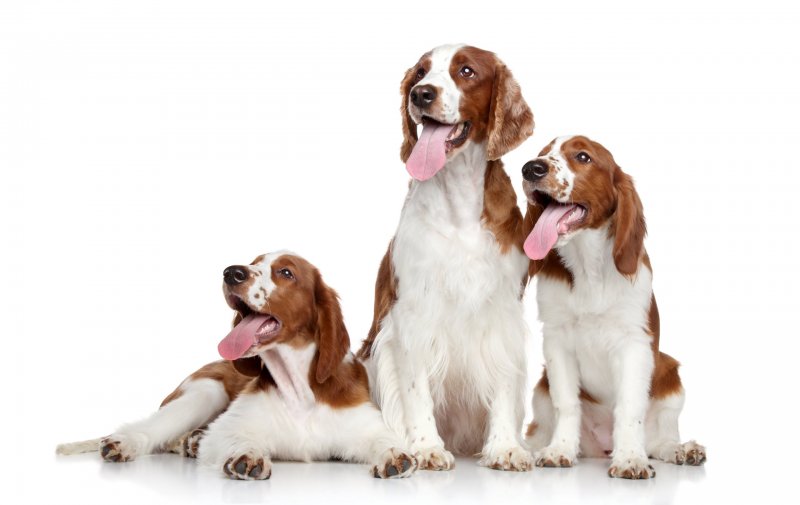
From Adobe Stock
When you buy or adopt a Welsh Springer Spaniel, it is important to find out what brand of food it was eating before bringing it home. Starting a two-month-old puppy on a new brand of food can give him an upset stomach. If you want to switch brands, do it gradually over the course of a week by mixing the two brands together in your pet’s bowl, and gradually decreasing the amount of the old food.
Welsh Springer Spaniels need four meals a day, from two to three months old. They eat about 200g of food per day (50g at each meal). Since they are eating so frequently, you need to remember to take them out to relieve themselves more often. Welsh Springer Spaniel puppies grow very fast and need about three times the amount of food that an adult of the same breed requires – in relation to his weight.
Between four and six months old, the puppy needs only twice the amount of food that an adult eats. The dog food you buy for him should have lots of protein and fat and preferably manufactured especially for puppies. He needs about 700 calories per day, which you can divide between kibble and meat products, or feed him just kibble.
From six to twelve months of age, your Welsh Springer Spaniel will not be growing that much. He will have already almost reached his full height and weight. By this stage in his growth, your puppy only needs to be fed twice a day – once in the morning, and once in the evening. Now he needs about 900 calories per day. Overfeeding will cause your Welsh Springer Spaniel to become obese.
Contact your vet early on to get advice regarding the best food for your Welsh Springer Spaniel, taking into consideration his breed, his age, and the amount of exercise he gets every day. When your puppy is still very young, if he has trouble chewing his kibble, add some warm water to it to soften it a bit. And make sure that the treats you feed your Welsh Springer Spaniel never account for more than 10% of his caloric requirements for a day.
Known Health Problems
Welsh Springer Spaniels are prone to the same diseases that many other dogs are: entropion, canine glaucoma, autoimmune thyroiditis, and hip and elbow dysplasia. Also, because they have hanging ears, they can get ear infections.
A condition called entropion can affect Welsh Springer Spaniels, causing the eyelids to curl inwards. The eyelashes then press against the eyeball, scratching and irritating it. This turn can damage the cornea. Symptoms of this disease include: rubbing the eyes, tearing, a thick discharge, squinting, and a visibly rolled eyelid that is with chronically wet eyelashes. There is no treatment for entropion, and surgery is only recommended and successful in certain cases. Entropion is usually detected soon after a dog is born, so it’s something to look for and ask about when buying a Welsh Springer Spaniel puppy.
Some Welsh Springer Spaniel inherit the gene for glaucoma. This is a disease that causes fluid buildup inside the eye, and if the amount of fluid is not reduced it causes pressure on the optic nerve and retina. Too much pressure can cause permanent damage to a dog’s eyesight and even blindness. Symptoms of glaucoma include rubbing the eyes on objects such as soft furniture or carpets, sensitivity to light, a red or cloudy eye. This condition usually affects one eye first, and then the other, and can be treated if caught on time.
Autoimmune thyroiditis – also known as hypothyroidism – occurs when the thyroid in a sense attacks itself. It is a genetic disease, and by testing as many dogs as possible in one pedigree breeders can identify dogs who are carriers as well as those who are already sick. If your Welsh Springer Spaniel has hypothyroidism, the first sign will be loss of fur on his trunk, backs of his rear legs, and his tail. The coat will start to look dull, and his skin will be flaky. As the disease progresses, your Welsh Springer Spaniel will gain weight, become sluggish, and possibly start to have seizures. Autoimmune thyroiditis is diagnosed with a simple blood test and is easily treated with medication your pet will have to take for the rest of his life.
Canine hip and elbow dysplasia can be either inherited or caused by environmental factors. It occurs when there is a malformation of the hip socket, which causes lameness and arthritis of the hip joints in varying degrees. CHD is quite rare in Welsh Springer Spaniels, but if they are diagnosed with this condition they should not be used for breeding. On the other hand, Welsh Springer Spaniels don’t usually suffer from hip and elbow dysplasia as much as larger breeds do. After age two, you can have your Welsh Springer Spaniel x-rayed to determine where or not he has this disease. In any case, before buying or adopting a Welsh Springer Spaniel, ask to see the health screens of both its parents to know it won’t be inheriting the painful condition.
Buyer’s Guide
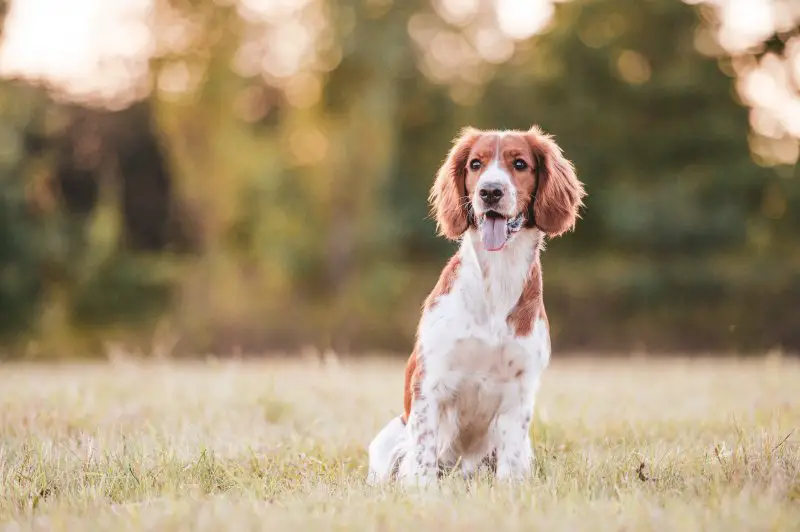
From Adobe Stock
How to Choose a Welsh Springer Spaniel Puppy
Welsh Springer Spaniel puppies are easier to find in the United Kingdom than elsewhere in the world. In the United States, for example, this breed is still quite rare and not very popular. In 2019, out of 193 breeds listed on the American Kennel Club website, Welsh Springer Spaniel came in 130th place! However, if you decide to buy a Welsh Springer Spaniel in the US, look for breeders registered with the American Kennel Club. You can be sure the puppies they offer for sale follow all rules and regulations established by the AKC.
Any breeder offering Welsh Springer Spaniel puppies for sale in the US should be able to show you the following certificates from BOTH of its parents:
- From the Orthopedic Foundation of American or PennHip – a certification that the dogs have normal hips.
- From the Orthopedic Foundation of America – a certification that the dogs have normal elbows.
- From the Orthopedic Foundation of America – a certification that the dogs have normal thyroids.
- From the Canine Eye Registry Foundation – a certification that the dogs are free of eye diseases, dated from the past year.
How Much Do Welsh Springer Spaniels Cost?
Welsh Springer Spaniels can cost anywhere from $1200 to $3500 dollars, depending on many different factors, such as:
- the puppy’s lineage
- the breeder’s reputation
- the breeder’s location – supply and demand, and accessibility
- the size of the litter
- socialization of the puppy before making the sale
Puppies with papers, but without show quality traits and or breeding rights, will come with cheaper price tags than top quality breeding dogs. Purchasing a puppy without any papers at all is risky and not recommended. If the Welsh Springer Spaniel you buy is not a purebred, you have no way of knowing what health or temperament problems it might come with, no matter how cute you think he is.
Quick Breed Summary Table
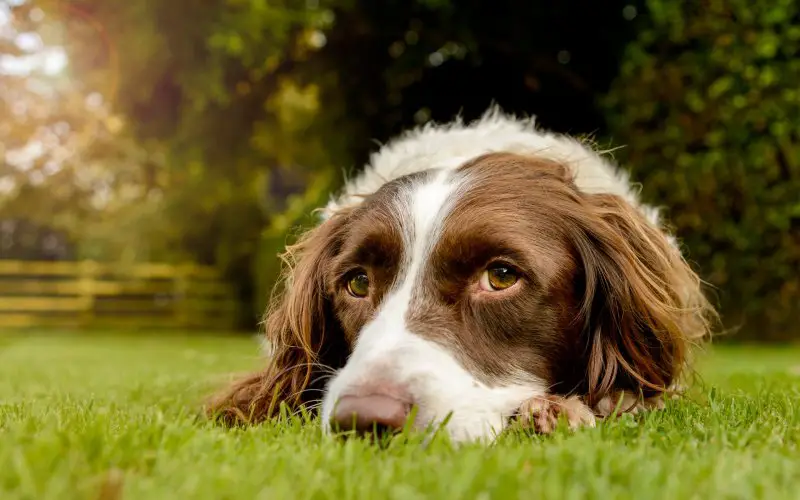
From Adobe Stock
The Welsh Springer Spaniel is very similar to the English Springer Spaniel, and the English Cocker Spaniel. If Welsh Springer Spaniels are so hard to come by, does it really matter if you get one of the other two breeds instead? Is there really that much of a difference between the three, aside from their coloring? The table below will help you understand what the similarities and differences are, so you can make an educated decision about which breed to search for and buy.
| Breed | Welsh Springer Spaniel | English Springer Spaniel | English Cocker Spaniel |
| Size | Weight – Male: 40-55 pounds (18-20 kg), Female: 35-50 pounds (16-20 kg) Height – Male: 18-19 inches (45 – 48 cm), Female: 17-18 inches (43 – 45) | Weight – Male: 45-55 pounds (20-25 kg), Female: 40-50 pounds (18-23 kg) Height – Male: 19-21 inches (48 – 56 cm), Female:18-20 inches (45-51 cm) | Weight – Male: 28-34 pounds (13-16 kg), Female: 26-32 pounds (12-15 kg) Height – Male: 15-17 inches (38-43 cm), Female: 14-16 inches (36-41 cm) |
| Color | bright red and white | black and white, or liver and white | blue, tan, black, liver, golden, and roan |
| Coat | Soft, straight, and silky | Feathered | |
| Temperament | Affectionate, playful, intelligent, friendly, stubborn, loyal | Affectionate, playful, intelligent, cheerful, social, alert | Affectionate, playful, intelligent, friendly, faithful, quiet |
| Family dog | excellent with the elderly, excellent with children, not very friendly towards strangers | does well with the elderly, does well with children, extremely stranger friendly | excellent with the elderly, excellent with children, average in terms of friendliness towards strangers |
| Trainability | Easy to train | Easy to train | Easy to train |
| Exercise needs | Need above average amount of exercise | Need an excessive amount of exercise | Need above average amount of exercise |
| Health problems | Hip and elbow dysplasia, Hypothyroidism, Glaucoma, Entropian | Hip and elbow dysplasia, Phosphofructokinase deficiency (Tarui disease, PFK), Progressive retinal atrophy, (PRA) Retinal Dysplasia | Hip and elbow dysplasia, ear infections, Cataracts, Renal failure |
| Lifespan | 12 – 15 years | 10 – 14 years | 12 – 14 years |
| Average Cost | $1200 – $1400 | $700 – $800 | $900 – $1200 |
Summary
If you want a lovable and loving, energetic and playful, intelligent and curious dog – the Welsh Springer Spaniel is a perfect choice. Before you make your final decision, make sure you are prepared to meet all of this breed’s exercise and companionship needs. You don’t want your dog to be one of the many who end up with Rescue organizations, looking for new homes, just because their owners weren’t prepared to walk them regularly for the next 12 years of their lives!
While it may be hard to find a Welsh Springer Spaniel to adopt, and it may take a while for a puppy to become available, it will be worth the wait. And once you own a Welsh Springer Spaniel, you will never have to worry about losing him in a crowd, or at the dog park, or anywhere else. His unique red and white coat will stand out among all the more common colored tan, brown, and black dogs.

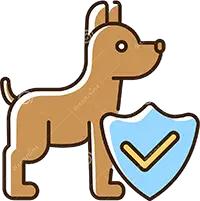

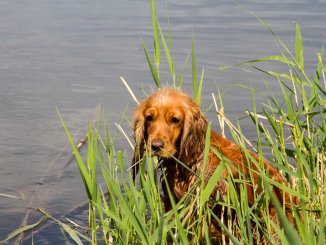


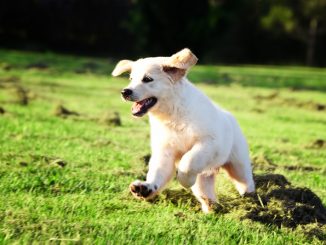


Be the first to comment